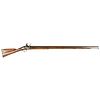1779 2nd Model British Short Land Brown Bess Revolutionary War Flintlock Musket
Lot 265
Categories
Estimate:
$6,500 - $8,500
Absentee vs Live bid
Two ways to bid:
- Leave a max absentee bid and the platform will bid on your behalf up to your maximum bid during the live auction.
- Bid live during the auction and your bids will be submitted real-time to the auctioneer.
Bid Increments
| Price | Bid Increment |
|---|---|
| $0 | $10 |
| $200 | $20 |
| $300 | $25 |
| $500 | $50 |
| $1,000 | $100 |
| $2,000 | $200 |
| $3,000 | $250 |
| $5,000 | $500 |
| $10,000 | $1,000 |
| $20,000 | $2,000 |
| $30,000 | $2,500 |
| $50,000 | $5,000 |
| $100,000 | $10,000 |
| $200,000 | $20,000 |
| $300,000 | $25,000 |
| $500,000 | $50,000 |
About Auction
By Early American History Auctions
May 22, 2021
Set Reminder
2021-05-22 12:00:00
2021-05-22 12:00:00
America/New_York
Bidsquare
Bidsquare : Autographs-Colonial-Political-Americana
https://www.bidsquare.com/auctions/early-american-history-auctions/autographs-colonial-political-americana-6913
302 Lots of Rare, Historic Autographs, Americana, Civil War Era, George Washington, Abraham Lincoln, Slavery & Black History, Revolutionary War Era, Colonial America, Federal Period, War of 1812, Colonial Currency, Indian Peace Medals & more... Early American History Auctions auctions@earlyamerican.com
302 Lots of Rare, Historic Autographs, Americana, Civil War Era, George Washington, Abraham Lincoln, Slavery & Black History, Revolutionary War Era, Colonial America, Federal Period, War of 1812, Colonial Currency, Indian Peace Medals & more... Early American History Auctions auctions@earlyamerican.com
- Lot Description
Guns
Classic Pattern 1779 2nd Model British Short Land Brown Bess Revolutionary War Period Flintlock Musket
1779-1780 Revolutionary War Period, Pattern 1779 2nd Model British Short Land Brown Bess Flintlock Musket, Choice Very Fine.
A handsome, premium example of the famed Revolutionary War Period, Pattern 1779, 2nd Model British Short Land Brown Bess Flintlock Musket. This Brown Bess has a 42.25" long, .79 caliber, round steel smoothbore barrel, with a bayonet lug fitted to the top of the barrel at the muzzle. The breech of the barrel is struck on the top with the British Ordnance "Tower of London" Proof marks, a small "CROWN" over "GR" over the "BROAD ARROW" (showing government ownership) and a small "CROWN" over the "CROSSED SEPTERS" are present. The left side of the breech is stamped with a barrel makers mark which may be a "STAR" over "DG" (likely Daniel Goff). The very end of the barrel tang has a small "CROWN" inspectors mark, and exhibits an overall even natural dark patina. The lock is engraved with a "CROWN" over the "GR" (King George III), a small "CROWN" over the "BROAD ARROW" (government ownership), a "G" visible between the leaves of the frizzen spring, and "TOWER" on the tail of the lock plate (TOWER of LONDON). The lock has the earlier pattern frizzen spring which was discontinued after the Pattern 1768 Short Land Musket.
This fine quality Musket appears to be in its Original Flintlock Configuration. The steel "button top" ram rod appears to be the very original issued with this gun. The stock is stamped "IR" just behind the brass side plate and has inspectors' marks at the tail of the trigger guard, a small "CROWN", a small "CROWN" over "6" and a "7". The stock has some darker tone areas, a few small areas of small spots of wood fill in a few of the barrel pin areas, otherwise fully solid with typical light scratches and dings from years of military service and handling. A wonderful example that was made for use during the American Revolutionary War that is in good mechanical working order. A true museum quality example that is excellent for display.
See Ref.: pp. 722-731, "FLAYDERMAN'S GUIDE TO ANTIQUE AMERICAN FIREARMS... and their values", by Norm Flayderman, 9th edition, 2007.
See Ref.: pp. 65-68, "BATTLE WEAPONS of the American Revolution" by George C. Neumann, 1998.
See Ref.: pp. 153-160, "Small Arms of the British Forces in America 1664-1815," by De Witt Bailey, Ph.D., 2009.
According to author George C. Neumann, after the French entered the American Revolutionary War as ally to the American Continental Army in 1778 (followed by Spain and Holland in successive years), the disciplined system installed by the Board of Ordnance for pattern guns were relaxed.
Several thousand firearms were accepted as final weapons from contractors without complete Tower-issued components or interim inspections, allowing the independent gunmakers to include their own barrels, locks and brass furniture.
This current Musket features the "S"-shaped convex side plate without a tail, which was the design in use on the India Pattern Musket being manufactured at the same time for the British East India Company. The musket also has the improved second ram rod pipe (ferrule), "PRATT'S" improvement which in design slopes forward to an enlarged mouth that was already in use in 1777, and this Musket was fitted with a Short Land Pattern 1768/1777 lock.
Our Auction Contents:
Black History & Slavery: (Lots 1 - 63)
Abraham Lincoln Related: (Lots 64 - 74)
Historic Autographs: (Lots 75 - 235)
Colonial America: (Lots 236 - 261)
Revolutionary War: (Lots 262 - 304)
George Washington Related: (Lots 305 - 306)
Early American Guns & Weapons: (Lots 307 - 318) - Shipping Info
-
Early American provides in-house worldwide shipping. Please contact us directly if you have questions about your specific shipping requirements.
-
- Buyer's Premium



 EUR
EUR CAD
CAD AUD
AUD GBP
GBP MXN
MXN HKD
HKD CNY
CNY MYR
MYR SEK
SEK SGD
SGD CHF
CHF THB
THB


















